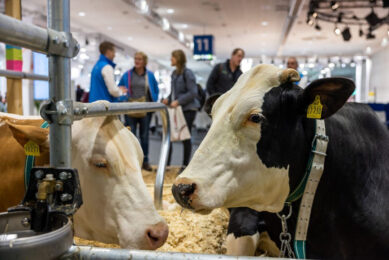14 Tips to decrease ammonia emissions in dairy cattle

The reduction of emissions from animal production is becoming increasingly more important. Here are 14 tips for dairy production gathered by the author from experts.
![]() Decrease the crude protein in the ration. In an average ration, dairy farmers feed 16 to 16.5% crude protein, which can be decreased further.
Decrease the crude protein in the ration. In an average ration, dairy farmers feed 16 to 16.5% crude protein, which can be decreased further.
![]() Coordinate protein and energy in the ration (4 times more rumen energy than rumen protein is optimal). This yields the highest nitrogen efficiency and the lowest nitrogen emission.
Coordinate protein and energy in the ration (4 times more rumen energy than rumen protein is optimal). This yields the highest nitrogen efficiency and the lowest nitrogen emission.
![]() Offer feed with little rumen degradable protein (RDP) levels and plenty of energy because this is suitable to decrease nitrogen excretion.
Offer feed with little rumen degradable protein (RDP) levels and plenty of energy because this is suitable to decrease nitrogen excretion.
![]() Offer (by)products with a high level of starch or sugar, such as fodder beets, grains such as crushed wheat, soda grain or potato(products).
Offer (by)products with a high level of starch or sugar, such as fodder beets, grains such as crushed wheat, soda grain or potato(products).
![]() Increase the level of maize silage (low in protein with a negative RDP and much starch) in the ration. This improves protein use (by capturing surplus rumen protein and stimulating milk protein production).
Increase the level of maize silage (low in protein with a negative RDP and much starch) in the ration. This improves protein use (by capturing surplus rumen protein and stimulating milk protein production).
![]() Offer good quality roughage and an optimal protein level with an optimal fertilising and mowing routine. Prevent heat generation and mould because this decreases protein quality and feed intake. You may want to use an ensilage agent.
Offer good quality roughage and an optimal protein level with an optimal fertilising and mowing routine. Prevent heat generation and mould because this decreases protein quality and feed intake. You may want to use an ensilage agent.
![]() Try to ensilage dryer grass, because this decreases the breakdown of protein through the fermentation process (less soluble protein/ammonia formation) during ensilaging. This yields more intestinal digestible protein and less RCP. Only use dryer grass when you can densify well.
Try to ensilage dryer grass, because this decreases the breakdown of protein through the fermentation process (less soluble protein/ammonia formation) during ensilaging. This yields more intestinal digestible protein and less RCP. Only use dryer grass when you can densify well.
![]() Feed more fresh grass instead of grass silage because fresh grass has lower RCP levels and higher intestinal digestible protein levels than silage, which decreases nitrogen emission.
Feed more fresh grass instead of grass silage because fresh grass has lower RCP levels and higher intestinal digestible protein levels than silage, which decreases nitrogen emission.
![]() Focus on high rumen fermentation with little protein surplus (low RCP) relative to energy in the rumen because this increases the efficiency of microbial protein formation and decreases protein loss.
Focus on high rumen fermentation with little protein surplus (low RCP) relative to energy in the rumen because this increases the efficiency of microbial protein formation and decreases protein loss.
![]() Aim for less youngstock because this decreases nitrogen excretion at a farm level. Intensify calf rearing, so heifers can calf at a younger age.
Aim for less youngstock because this decreases nitrogen excretion at a farm level. Intensify calf rearing, so heifers can calf at a younger age.
![]() Aim for a higher production per cow and a longer life span.
Aim for a higher production per cow and a longer life span.
![]() Improve cow health (with optimal transition management) because this improves feed efficiency and protein use. Less sickness also improves the life span.
Improve cow health (with optimal transition management) because this improves feed efficiency and protein use. Less sickness also improves the life span.
![]() Add additives to manure to limit ammonia emissions.
Add additives to manure to limit ammonia emissions.
![]() Add water to slurry during spreading in the field.
Add water to slurry during spreading in the field.
To see full article on Influencing rumen microbes improves nitrogen efficiency










